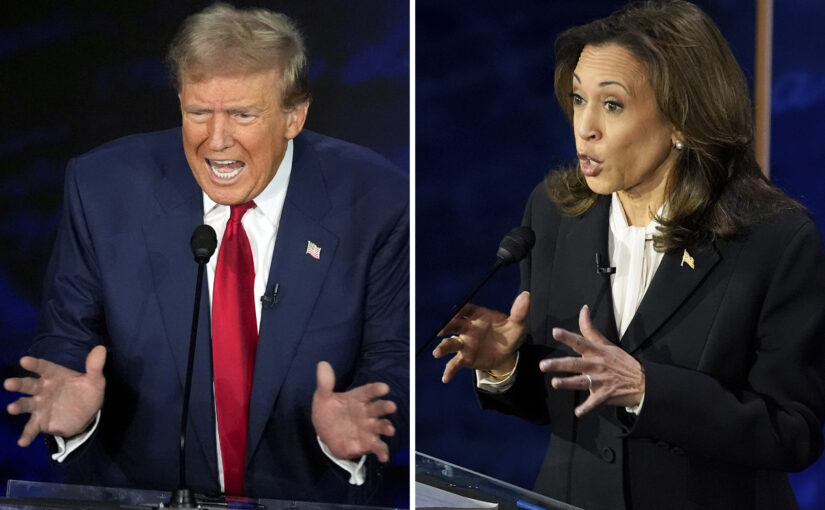Harris vs Trump: policies at odds
Written by Joey Bartlett on November 5, 2024

The 2024 US presidential election pitted vice president Kamala Harris against former president Donald Trump and is widely regarded as one of the most historic ever.
Days before the election, more than 80 million Americans had already cast their ballots early.
Harris, who has served as the first woman and first woman of colour in the vice presidency, was tasked with convincing voters in just 100 days that she was the best choice, while Trump announced his candidacy in 2022.
Their contrasting platforms reflect the deep political divide in the US.
Harris focused on addressing systemic inequality, promoting social justice and expanding civil rights and social safety nets for working Americans.
In contrast, Trump advocates for a return to a golden age of American prosperity, emphasising economic revival, lower taxes and stricter immigration policies under his Make America Great Again slogan.
Key issues on the campaign include abortion and reproductive rights, immigration, healthcare, the economy and climate change. While the economy remains the top issue for voters, abortion and women’s reproductive rights became a central factor in electoral decisions, particularly in swing states.
Harris, alongside president Joe Biden, has supported federal protections for abortion rights, pushing for the Women’s Health Protection Act to restore access nationwide after the overturning of Roe v Wade.
Trump’s position on abortion has shifted repeatedly despite appointing Supreme Court justices who voted to overturn Roe v Wade. He suggested he might support a Florida ballot measure expanding abortion rights, though his campaign later walked back these comments. By the end of his campaign, he said abortion policy should be left to individual states.
After the Supreme Court’s June 2022 decision in Dobbs v Jackson Women’s Health Organisation, which eliminated the constitutional right to abortion, nearly two dozen states moved to ban or severely restrict access to the procedure.
The legal landscape continues to evolve. Georgia Supreme Court reinstated the state’s six-week abortion ban, which had been struck down by a lower court, while legal challenges persist. In North Dakota, a judge overturned the state’s near-total abortion ban in September, permitting abortions up to the point of foetal viability. However, there are no remaining clinics in the state, according to the Center for Reproductive Rights.
In June, the Supreme Court ruled to allow emergency abortions in Idaho temporarily and also rejected a challenge to the FDA’s regulation of mifepristone, the first drug in a two-drug medication abortion regimen. As a result, the abortion pill remains available to patients via mail without the need for an in-person doctor’s visit.
On immigration, Harris and Biden support a path to citizenship for undocumented immigrants, though efforts have stalled in Congress. Biden has urged lawmakers to provide more tools to manage an overwhelmed border and create new legal pathways for migrants.
Biden and Harris have championed a bipartisan bill aimed at raising the bar for asylum eligibility and turning away migrants who do not qualify. The bill would also give the president the power to temporarily close the border if migration levels hit certain thresholds, but Republicans have blocked the legislation in the Senate.
In contrast, Trump advocates for strict border security measures, including the Remain in Mexico policy. He portrays illegal immigration as a national security threat and has promised a crackdown on illegal immigration.
His campaign website pledges to “shut down Biden’s border disaster,” end “catch-and-release” policies and eliminate asylum fraud, among other proposals. Additionally, Trump has called for deputising the National Guard and law enforcement in co-operative states to assist with the removal of illegal immigrants, particularly gang members and criminals.
Healthcare was another major issue in the campaign, with Harris supporting the expansion of the Affordable Care Act (ACA) and efforts to lower prescription drug prices.
In 2010, the Biden administration helped pass the ACA, and he, along with Harris, continued to defend it. The ACA has provided coverage to 45 million people through subsidies, mandates and Medicaid expansion.
Trump, however, opposes the ACA and calls for its repeal, advocating for tax cuts and deregulation, arguing it will boost economic growth. During his presidency, Trump attempted to repeal the ACA through legislation and executive action. In this campaign, he said he wanted to improve the ACA but did not propose an alternative plan.
Taxes have been a major focus, particularly the Trump-era tax cuts from 2017 that are set to expire this year: their fate lies in the hands of the election winner. Trump has called for extending these tax cuts, arguing they are key to economic growth, especially for top earners. If re-elected, he has pledged to maintain the framework.
The Harris camp has criticised the 2017 tax law, saying big corporations and the ultra-wealthy should pay their fair share.
Harris and Biden support raising the corporate tax rate from 21 to 28 per cent.
In trade, Trump has proposed a ten per cent tariff on all imported goods if he returns to office, a plan that Harris’s campaign strongly opposes. They argue the tariff would increase inflation and raise taxes and prices by US$1,500 per American family, citing estimates from the Center for American Progress.
On foreign policy, Harris favours continued support for Ukraine, which is facing critical shortages of ammunition as it battles Russia. Trump, while supportive of NATO, has distanced himself from further aid to Ukraine.
Since Republicans took control of the House in January 2023, Trump has successfully influenced them to block additional aid.
The post Harris vs Trump: policies at odds appeared first on Trinidad and Tobago Newsday.




